 The unauthorized use of photography is a major concern for photographers who license their images for use on the web. Technologies such as PicScout Image Tracker are used by stock photography companies to scour the web looking for unauthorized pictures. These tools scan websites and blogs and have been around for a while and, in a mildly creepy twist, even have built in links that help you contact a lawyer when an infringement is located.
The unauthorized use of photography is a major concern for photographers who license their images for use on the web. Technologies such as PicScout Image Tracker are used by stock photography companies to scour the web looking for unauthorized pictures. These tools scan websites and blogs and have been around for a while and, in a mildly creepy twist, even have built in links that help you contact a lawyer when an infringement is located.
Google’s Similar Images Search
Google has entered this fray with a fledgling technology called Google Similar Images search. I have played around with it and found that in general, it’s a rather weak, not nearly as powerful as Picscout or other image-driven search engines like TinEye, which lets you send a photo as a query. But Google’s tool is in early beta and we can expect it to improve given Google’s amazing computing power. Perhaps someday we can set up saved searches that ping us when an image we created gets dropped on another site?
Can’t Find Licenses For Your Images? Watch Out.
Website owners who inherit sites from others or have photos on their site that they cannot be sure of may be able to check to see if the image is part of a stock library. This could help website and blog owners move towards license compliance and prevent high settlements. But I still recommend that any website owner who cannot locate the license or source of any images remove it immediately, then investigate – not the other way around.
So How Big Is The Problem?
Pictscout says that over 90% of images on the web are infringed (probably mostly adult images, I wonder?) Even if the number is less for non-adult images, I’ll agree that infringement is rampant, largely due to lack of understanding, respect for the art of photography or just plain laziness. Probably 20% of the sites that I audit or review have images that are “grabbed from Google” or “Found on Flickr” and put on the site sans license or attribution, and I’d guess that this is even higher for blogs.
Settlements Can Be Large
I always make a fuss about it because the settlement costs can be huge – especially on rights managed images. I have received calls from a dozen or more people in past years with settlements as high as $20,000 on their desks after I first wrote about this. Sadly, all I could recommend is that they be sympathetic, reasonable and see if they could negotiate down the number. The law is entirely on the photographer’s side and it’s hard to refute a screen shot, and some have rather devious ideas on how to use this kind of information. There are a lot of discussions about this in Flickr’s Licensing Awareness Working Group
Sources For Free, Legal Images
Tip: If you’d like to use images on your blog, try using the Creative Commons search tool. Look for attribution images licensed for commercial use. Drop a link to the photographer and a comment in your post, and you’re golden – this gives you access to millions of images the photographers have offered up for use. But beware: If the photographer didn’t take the photograph themself, and then posted it as creative commons, you are still liable!
Here is a simple search I did and the results:

Google Similar Image Search
Clearly, it’s very primitive yet, but it will get better.
Please share your thoughts
Camera photo by Thibault Martin-Lagardette used under CC attribution license.








I often wonder about some of my images that seem to turn up on mobile phones as backdrops. I was talking to a friend of friend who dabbles in short films and he showed me is phone and said I have downloaded one of your images to my phone. I could have mentioned copyright but to be quite honest I was flattered. At that time I thought it was strange to see one of my creations as wallpaper especially because the images of that series were printed as a limited addition.